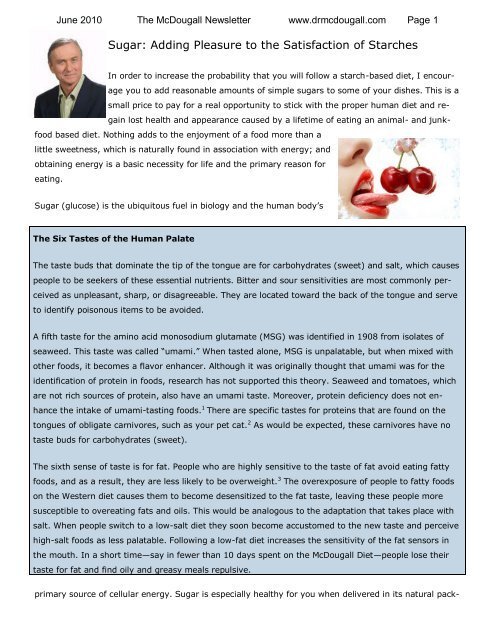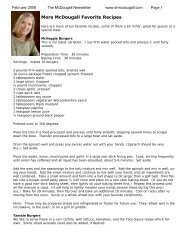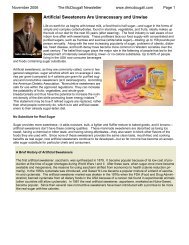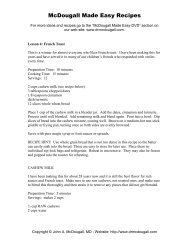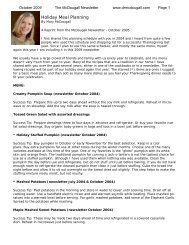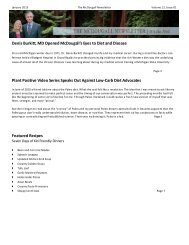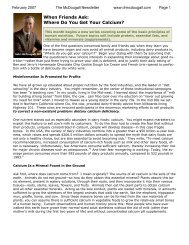Sugar: Adding Pleasure to the Satisfaction of Starches - Dr. McDougall
Sugar: Adding Pleasure to the Satisfaction of Starches - Dr. McDougall
Sugar: Adding Pleasure to the Satisfaction of Starches - Dr. McDougall
You also want an ePaper? Increase the reach of your titles
YUMPU automatically turns print PDFs into web optimized ePapers that Google loves.
June 2010 The <strong>McDougall</strong> Newsletter www.drmcdougall.com Page 1<strong>Sugar</strong>: <strong>Adding</strong> <strong>Pleasure</strong> <strong>to</strong> <strong>the</strong> <strong>Satisfaction</strong> <strong>of</strong> <strong>Starches</strong>In order <strong>to</strong> increase <strong>the</strong> probability that you will follow a starch-based diet, I encourageyou <strong>to</strong> add reasonable amounts <strong>of</strong> simple sugars <strong>to</strong> some <strong>of</strong> your dishes. This is asmall price <strong>to</strong> pay for a real opportunity <strong>to</strong> stick with <strong>the</strong> proper human diet and regainlost health and appearance caused by a lifetime <strong>of</strong> eating an animal- and junkfoodbased diet. Nothing adds <strong>to</strong> <strong>the</strong> enjoyment <strong>of</strong> a food more than alittle sweetness, which is naturally found in association with energy; andobtaining energy is a basic necessity for life and <strong>the</strong> primary reason foreating.<strong>Sugar</strong> (glucose) is <strong>the</strong> ubiqui<strong>to</strong>us fuel in biology and <strong>the</strong> human body’sThe Six Tastes <strong>of</strong> <strong>the</strong> Human PalateThe taste buds that dominate <strong>the</strong> tip <strong>of</strong> <strong>the</strong> <strong>to</strong>ngue are for carbohydrates (sweet) and salt, which causespeople <strong>to</strong> be seekers <strong>of</strong> <strong>the</strong>se essential nutrients. Bitter and sour sensitivities are most commonly perceivedas unpleasant, sharp, or disagreeable. They are located <strong>to</strong>ward <strong>the</strong> back <strong>of</strong> <strong>the</strong> <strong>to</strong>ngue and serve<strong>to</strong> identify poisonous items <strong>to</strong> be avoided.A fifth taste for <strong>the</strong> amino acid monosodium glutamate (MSG) was identified in 1908 from isolates <strong>of</strong>seaweed. This taste was called “umami.” When tasted alone, MSG is unpalatable, but when mixed witho<strong>the</strong>r foods, it becomes a flavor enhancer. Although it was originally thought that umami was for <strong>the</strong>identification <strong>of</strong> protein in foods, research has not supported this <strong>the</strong>ory. Seaweed and <strong>to</strong>ma<strong>to</strong>es, whichare not rich sources <strong>of</strong> protein, also have an umami taste. Moreover, protein deficiency does not enhance<strong>the</strong> intake <strong>of</strong> umami-tasting foods. 1 There are specific tastes for proteins that are found on <strong>the</strong><strong>to</strong>ngues <strong>of</strong> obligate carnivores, such as your pet cat. 2 As would be expected, <strong>the</strong>se carnivores have notaste buds for carbohydrates (sweet).The sixth sense <strong>of</strong> taste is for fat. People who are highly sensitive <strong>to</strong> <strong>the</strong> taste <strong>of</strong> fat avoid eating fattyfoods, and as a result, <strong>the</strong>y are less likely <strong>to</strong> be overweight. 3 The overexposure <strong>of</strong> people <strong>to</strong> fatty foodson <strong>the</strong> Western diet causes <strong>the</strong>m <strong>to</strong> become desensitized <strong>to</strong> <strong>the</strong> fat taste, leaving <strong>the</strong>se people moresusceptible <strong>to</strong> overeating fats and oils. This would be analogous <strong>to</strong> <strong>the</strong> adaptation that takes place withsalt. When people switch <strong>to</strong> a low-salt diet <strong>the</strong>y soon become accus<strong>to</strong>med <strong>to</strong> <strong>the</strong> new taste and perceivehigh-salt foods as less palatable. Following a low-fat diet increases <strong>the</strong> sensitivity <strong>of</strong> <strong>the</strong> fat sensors in<strong>the</strong> mouth. In a short time—say in fewer than 10 days spent on <strong>the</strong> <strong>McDougall</strong> Diet—people lose <strong>the</strong>irtaste for fat and find oily and greasy meals repulsive.primary source <strong>of</strong> cellular energy. <strong>Sugar</strong> is especially healthy for you when delivered in its natural pack-
June 2010 The <strong>McDougall</strong> Newsletter www.drmcdougall.com Page 2aging, more specifically in starches, vegetables, and fruits. However, popular thinking is that all sugar isbad, and that veil <strong>of</strong> aspersion is cast over all sugar-containing foods, including much maligned rice andpota<strong>to</strong>es. This unjustifiable fear <strong>of</strong> sugar is a major reason for <strong>the</strong> present day exponential expansion <strong>of</strong><strong>the</strong> worldwide epidemics <strong>of</strong> obesity, type-2 diabetes, heart disease, arthritis, intestinal disorders, andcancers. (Instead <strong>of</strong> sugar-phobia, people should be having fat-, oil- and animal food-phobias.) Yourhealth will skyrocket with my recommendation <strong>to</strong> add sensible amounts <strong>of</strong> simple sugars <strong>to</strong> your energy-supplying,appetite-satisfying, starch-based meals.<strong>Sugar</strong> is fat-free, cholesterol-free, and sodium-free, and contains very low levels <strong>of</strong> chemical residues.It is inexpensive, costing about 40 cents a pound, which translates in<strong>to</strong> 45 calories per penny. No animalsare harmed in <strong>the</strong> production <strong>of</strong> sugar and its environmental impact is extremely small, especiallywhen compared <strong>to</strong> lives<strong>to</strong>ck production. According <strong>to</strong> <strong>the</strong> <strong>Sugar</strong> Association, “Pure and simple, sugar isas perfect as it gets.”Refining Carbohydrates Intensifies <strong>Pleasure</strong>The carbohydrates found in natural foods are isolated and concentrated by manufacturing processesand turned in<strong>to</strong> millions <strong>of</strong> commercial food products. The most widespread examples <strong>of</strong> <strong>the</strong>se highlyprocessed foods are table sugar (sucrose, from sugarcane or sugar beets) and corn syrup (from corn).These purified simple carbohydrates deliver intense stimulation <strong>to</strong> <strong>the</strong> user, just like <strong>the</strong> alkaloids cocaineand opium, purified from <strong>the</strong> coca leaf and <strong>the</strong> poppy plant, respectively, give utmost pleasure <strong>to</strong><strong>the</strong>ir users. Eating sugar causes immediate changes in <strong>the</strong> brain’s chemistry, similar <strong>to</strong> those seen after<strong>the</strong> use <strong>of</strong> narcotics, which produces heightened pleasure. 4A comparable, but less intense enhancement <strong>of</strong> flavor is accomplished by eating <strong>the</strong> flours <strong>of</strong> refinedgrains. When wheat berries are refined in<strong>to</strong> whole-wheat flour and <strong>the</strong>n purified fur<strong>the</strong>r in<strong>to</strong> white flour,<strong>the</strong>ir carbohydrates become more concentrated, exposed, and available for taste. Highly refined productsare very arousing <strong>to</strong> <strong>the</strong> palate. Similarly, sweet sensory stimulation is enhanced when brown riceis polished in<strong>to</strong> white rice. It is in our nature <strong>to</strong> enjoy carbohydrates, and <strong>the</strong> more intense <strong>the</strong> stimulus<strong>the</strong> better. However, <strong>the</strong> refining processes also results in less satisfaction <strong>of</strong> <strong>the</strong> hunger drive whenflour is consumed instead <strong>of</strong> whole grain. 5Taking Advantage <strong>of</strong> Your <strong>Sugar</strong> AddictionThroughout most <strong>of</strong> human existence starches were <strong>the</strong> predominate source <strong>of</strong> sweets. Their level <strong>of</strong>sensory stimulation is relatively low, but <strong>to</strong> <strong>the</strong>ir advantage, corn, rice, beans, and pota<strong>to</strong>es do providefor long-term satisfaction <strong>of</strong> <strong>the</strong> appetite. Very sweet-tasting natural foods, such as fruits, maple syrup,and honey, provide for only short-term satiety. 6 Refined sugars, so abundant in <strong>the</strong> Western diet, alsoprovide intense taste stimulation, but short-lived satisfaction <strong>of</strong> hunger. 6 Combining <strong>the</strong> long-term sat-
June 2010 The <strong>McDougall</strong> Newsletter www.drmcdougall.com Page 3isfaction from starches with <strong>the</strong> intense flavor from sugars greatly enhances <strong>the</strong> acceptance <strong>of</strong> and <strong>the</strong>compliance with a starch-based diet. The end result is people are tricked in<strong>to</strong> enjoying healthy foodseven more.Do you find my use <strong>of</strong> this kind <strong>of</strong> deception troubling? People following <strong>the</strong> Western diet are alreadyhooked on (habituated <strong>to</strong> or addicted <strong>to</strong>) high levels <strong>of</strong> salt and sugar that are laced throughout <strong>the</strong>irfood supply. Ideally, I would simply ask <strong>the</strong>m <strong>to</strong> break <strong>the</strong>ir existing addictions and s<strong>to</strong>p using all refinedsimple sugars and added salt. However this stringent approach is a huge adjustment, and fortunatelyunnecessary for most people <strong>to</strong> regain <strong>the</strong>ir lost health and appearance.These adulterants, salt and sugar, are necessary <strong>to</strong> cover up <strong>the</strong> bland, and <strong>of</strong>ten repugnant tastes <strong>of</strong>animal muscles and organs, and <strong>the</strong> lactation fluids that serve as <strong>the</strong> foundations <strong>of</strong> <strong>the</strong> Western diet.Think about eating plain boiled chicken or beef, or salt-less cheese. Unpalatable! My plan is <strong>to</strong> simplyswitch <strong>the</strong> foundations <strong>of</strong> your meals <strong>to</strong> <strong>the</strong> relatively bland but appealing flavors <strong>of</strong> rice, corn, pota<strong>to</strong>es,and beans. Then enhance that attraction <strong>to</strong> <strong>the</strong>se healthy starches with familiar sauces and graviesthat you have grown accus<strong>to</strong>med <strong>to</strong> throughout your entire life. Think <strong>of</strong> barbecue, sweet and sour,steak, and curry sauces, and/or any <strong>of</strong> a variety <strong>of</strong> marinades covering up or mixed up with commonstarches, and a variety <strong>of</strong> green and yellow vegetables. Delicious! The end result <strong>of</strong> this small culinarycompromise is a giant leap forward in your health. Compliance now becomes effortless with <strong>the</strong> improvedpalatability <strong>of</strong> <strong>the</strong> meals.You won’t miss <strong>the</strong> grease and oil ei<strong>the</strong>r. These substances are inherently repulsive. What do you call arestaurant with a bad reputation? A greasy spoon. Oils are so disgusting that you make great efforts <strong>to</strong>wash your hands and face free <strong>of</strong> <strong>the</strong>m, and use strong grease-cutting detergents <strong>to</strong> clean your s<strong>to</strong>veand counter <strong>to</strong>ps.The starch solution depends upon individuals and entire populations adhering <strong>to</strong> my diet plan. However,<strong>the</strong>re are prices <strong>to</strong> be paid for this concession. You need <strong>to</strong> know <strong>the</strong> truth about sugars in order <strong>to</strong>make rational decisions. In <strong>the</strong> end <strong>the</strong> benefits <strong>of</strong> adding simple sugars far outweigh <strong>the</strong> costs for mostpeople.The Effects <strong>of</strong> Dietary <strong>Sugar</strong>s on Blood <strong>Sugar</strong>The changes in blood sugar that occur after eating can be measured and are reported as a glycemic index(GI). The GI compares <strong>the</strong> rise in blood sugar over <strong>the</strong> two <strong>to</strong> three hours following a carbohydrate-containingfood <strong>to</strong> a standard reference (such as 50 grams <strong>of</strong> white table sugar). The final result,<strong>the</strong> GI, is expressed as a percentage. Because very large rises in blood sugar are characteristic <strong>of</strong> <strong>the</strong>disease diabetes, both lay people and pr<strong>of</strong>essionals commonly believe that foods with a high GI areharmful. This is incorrect. Worldwide, populations <strong>of</strong> hundreds <strong>of</strong> millions <strong>of</strong> people who eat large quan-
June 2010 The <strong>McDougall</strong> Newsletter www.drmcdougall.com Page 4Forms <strong>of</strong> Carbohydrate* Simple sugars include white table sugar (sucrose) and high-fruc<strong>to</strong>se corn syrup. But simple sugarsare also <strong>the</strong> main ingredients in sweet-tasting honey, molasses, agave, and maple syrup. All <strong>of</strong> <strong>the</strong>seconcentrated simple sugars contain 2.5 <strong>to</strong> 4 calories per gram <strong>of</strong> mostly “empty calories.” The lac<strong>to</strong>se inmo<strong>the</strong>r’s milk is also simple sugar swimming with essential nutrients. And eating fruits with <strong>the</strong>ir plentifulsupply <strong>of</strong> simple sugars and o<strong>the</strong>r nutrients is quite healthful.* Complex carbohydrates are long branching chains <strong>of</strong> simple sugars connected <strong>to</strong>ge<strong>the</strong>r by digestiblelinkages. They provide <strong>the</strong> bulk <strong>of</strong> <strong>the</strong> energy for <strong>the</strong> body. Most <strong>of</strong> <strong>the</strong> sugars found in starches andgreen and yellow vegetables are complex carbohydrates, and are found in combination with o<strong>the</strong>rhealthful nutrients. The carbohydrates found in refined grains, such as white rice and flours, are alsocomplex in nature.* Dietary Fiber is ano<strong>the</strong>r form <strong>of</strong> complex carbohydrate, but <strong>the</strong> human intestine cannot digest <strong>the</strong>sechains because <strong>of</strong> <strong>the</strong> resistant linkages between <strong>the</strong> simple sugars. Although providing no calories, fiberis important for proper bowel and general health. Fiber is found in all unprocessed plant foods but neverin animal foods (meat, cheese, fish, etc.).* Glycogen is ano<strong>the</strong>r form <strong>of</strong> complex sugar. Syn<strong>the</strong>sized by people and o<strong>the</strong>r animals, <strong>the</strong>se branchingchains <strong>of</strong> sugars are s<strong>to</strong>red in <strong>the</strong> muscles and liver <strong>to</strong> provide energy for future activities.tities <strong>of</strong> high-GI pota<strong>to</strong>es (Peruvians) and rice (Asians) are trim, active, and young-looking, and are essentiallyfree <strong>of</strong> diabetes. 7,8 Contrast that observation with populations <strong>of</strong> obese, sickly people living in<strong>the</strong> US, Australia, and Western Europe who feast daily on low GI simple sugars, fats, meats, andcheeses.The rise in blood sugar that follows eating is normal, expected, and desirable. We eat for energy. TheGI is a measurement <strong>of</strong> <strong>the</strong> effectiveness <strong>of</strong> a food in providing us with life-sustaining fuel. GI <strong>of</strong> a fooddoes not predict excess calorie consumption or weight gain for <strong>the</strong> consumer. In fact, high-GI starchesprevent weight gain in those people with a tendency for obesity. 9,10 The elevation <strong>of</strong> <strong>the</strong> blood sugarthat follows eating is one <strong>of</strong> <strong>the</strong> key mechanisms in satisfying <strong>the</strong> appetite and reducing food intake. 11Pota<strong>to</strong>es with a high GI are found <strong>to</strong> be twice as satisfying as meat or cheese. 6Used in isolation, <strong>the</strong> GI can lead <strong>to</strong> some erroneous conclusions. According <strong>to</strong> a popular practice <strong>of</strong>judging foods based solely on GI you would be making healthier choices by eating chocolate cake instead<strong>of</strong> carrots and cheese-<strong>to</strong>pped pizza ra<strong>the</strong>r than pota<strong>to</strong>es.
June 2010 The <strong>McDougall</strong> Newsletter www.drmcdougall.com Page 5Low GI Doesn’t Necessarily Equate with Healthy 12Junk Foods with GI less than 40Healthy Foods with GI greater than 80Chocolate Cake (38)Nabisco Shredded Wheat (83)Nestle Quick Strawberry <strong>Dr</strong>ink (35)Corn Meal Porridge (109)No Bake Egg Custard (35)Jasmine Rice (109)Sara Lee Premium Ice Cream (37)Brown Rice—Calrose (87)Chocolate Milk with <strong>Sugar</strong> (34)Corn Thins (87)M&Ms with Peanuts (33)Baked Pota<strong>to</strong> (85)Pizza Supreme (30)Boiled Pota<strong>to</strong> (101)Egg Fettuccine (32)Parsnips (97)Fruc<strong>to</strong>se (a pure sugar) (19)Carrots (92)Focusing on eating a low-glycemic-index diet while ignoring <strong>the</strong> o<strong>the</strong>r qualities <strong>of</strong> a food is especiallyhazardous because <strong>the</strong> easiest way <strong>to</strong> decrease <strong>the</strong> blood sugar response <strong>to</strong> a meal is <strong>to</strong> consume moreprotein and/or fat; <strong>the</strong> predominant ingredients in meat, poultry, eggs, and cheese. As you know well,<strong>the</strong>se animal foods damage your arteries, bones, and kidneys, leading <strong>to</strong> heart attacks, strokes, osteoporosis,kidney s<strong>to</strong>nes, kidney failure, and cancer.<strong>Sugar</strong> Does Not Cause Obesity nor DiabetesA universally accepted mantra among dieters is, “Don’t eat starches because starches turn in<strong>to</strong> sugars,and <strong>the</strong>n <strong>the</strong> sugars turn in<strong>to</strong> fats and make you fat.” If this were true <strong>the</strong>n obesity would be rampantamong rice-eating Japanese people. Obviously <strong>the</strong> opposite is <strong>the</strong> case. Worldwide, populations with <strong>the</strong>highest consumption <strong>of</strong> carbohydrate are <strong>the</strong> trimmest and fittest. 13 This truth is confirmed by observing<strong>the</strong> change in body size that occurs when people from Asia migrate <strong>to</strong> Western countries. As <strong>the</strong>yeat less rice (carbohydrate) <strong>the</strong>y become fatter and sicker.Studies also show that <strong>the</strong> higher a person’s sugar intake, <strong>the</strong> lower <strong>the</strong>ir calorie intake, and thus, <strong>the</strong>reis less chance <strong>of</strong> being overweight. 14 This observation makes a lot <strong>of</strong> sense. When carbohydrate (evenpure sugar) is added <strong>to</strong> <strong>the</strong> diet, fat is usually removed. Think <strong>of</strong> this as a kind <strong>of</strong> a sugar-fat seesaw:one goes up and <strong>the</strong> o<strong>the</strong>r must go down. 14 Fat is concentrated in calories at 9 per gram vs. 4 per gram
June 2010 The <strong>McDougall</strong> Newsletter www.drmcdougall.com Page 8Stevia Is a Natural, Safe, and Powerful SweetenerThere is a natural alternative for people who desire sweetness yet also choose <strong>to</strong> minimize <strong>the</strong>ir refinedsugar intake: stevia. From <strong>the</strong> leaves <strong>of</strong> a perennial shrub found in Paraguay and Brazil comes a substancethat is 200 <strong>to</strong> 300 times sweeter than table sugar. This stable sweetener is essentially caloriefreeand non-<strong>to</strong>xic, and <strong>the</strong>refore may be <strong>the</strong> best choice if you must use a sugar substitute. 40 Thistime-tested sugar substitute has been used for centuries in South America and Asia. Animal and humanstudies have demonstrated anti-hypertensive and anti-diabetic properties <strong>of</strong> stevia. 40-43 In <strong>the</strong> US, steviais sold as a “dietary supplement” ra<strong>the</strong>r than as a replacement for sugar (for legal reasons). You canpurchase stevia at natural food s<strong>to</strong>res and some supermarkets. The FDA does not approve stevia, nordoes <strong>the</strong> American Dietetic Association endorse it as a nonnutritive sweetener. This lack <strong>of</strong> <strong>of</strong>ficial supporthas been attributed <strong>to</strong> pressures from <strong>the</strong> sugar and artificial sweetener industries. The AmericanDietetic Association receives its funding from many industries, including those that manufacture artificialsweeteners and foods made with <strong>the</strong>se sugar substitutes and simple sugars. 44Give in and Satisfy Your <strong>Sugar</strong> NeedsUncontrollable cravings are caused by <strong>the</strong> Western diet’s deficiency <strong>of</strong> healthy sugars. People chewthrough platefuls <strong>of</strong> sugar (carbohydrate)-free beef, pork, chicken, shellfish, fish, and cheese withoutbecoming satisfied. Then at <strong>the</strong> end <strong>of</strong> <strong>the</strong> meal <strong>the</strong>y find a sugar and fat-filled dessert, a calorie-bomb<strong>of</strong> pleasure, a pie, an ice cream, or a cake. The rewardis like <strong>the</strong> fix for a deprived drug addict. Byconsuming starch-based meals, however, you willbe provided carbohydrate satisfaction with eachand every bite, so that at <strong>the</strong> end <strong>of</strong> <strong>the</strong> meal youare in complete control.Fighting your inborn love for sugar is as senselessas fighting your hunger drive; you are destined <strong>to</strong>lose. My recommendation is <strong>to</strong> eat first and foremost<strong>the</strong> natural sugars in starches, vegetables, and fruits. For additional pleasure, add some simplesugars. The most taste for <strong>the</strong> least sugar is accomplished by placing <strong>the</strong> sweetener on <strong>the</strong> surface <strong>of</strong><strong>the</strong> food where <strong>the</strong> tip <strong>of</strong> <strong>the</strong> <strong>to</strong>ngue can taste it directly. My experience has been that most people willenjoy <strong>the</strong>ir bowl <strong>of</strong> morning oatmeal even more with a teaspoon <strong>of</strong> brown sugar on <strong>to</strong>p ra<strong>the</strong>r thanplain. That spoonful <strong>of</strong> pleasure is only 16 additional calories. The same enhanced enjoyment comesfrom a drizzle <strong>of</strong> maple syrup over pancakes, molasses mixed in<strong>to</strong> baked beans, or a little barbecuesauce poured over pota<strong>to</strong>es. Simply put, for long-term compliance and a pleasure-filled life, your mealsmust taste great.
June 2010 The <strong>McDougall</strong> Newsletter www.drmcdougall.com Page 9References:1) Gary K Beauchamp. Sensory and recep<strong>to</strong>r responses <strong>to</strong> umami: an overview <strong>of</strong> pioneering work. AmJ Clin Nutr 2009 90: 723S-727S.2) Bradshaw JW, Goodwin D, Legrand-DefrÈtin V, Nott HM. Food selection by <strong>the</strong> domestic cat, an obligatecarnivore. Comp Biochem Physiol A Physiol. 1996 Jul;114(3):205-9.3) Stewart JE, Feinle-Bisset C, Golding M, Delahunty C, Clif<strong>to</strong>n PM, Keast RS. Oral sensitivity <strong>to</strong> fattyacids, food consumption and BMI in human subjects. Br J Nutr. 2010 Mar 3:1-8.4) Yamamo<strong>to</strong> T. Brain mechanisms <strong>of</strong> sweetness and palatability <strong>of</strong> sugars. Nutr Rev. 2003 May;61(5 Pt2):S5-9.5) Holt SH, Miller JB. Particle size, satiety and <strong>the</strong> glycaemic response. Eur J Clin Nutr. 1994Jul;48(7):496-502.6) Holt SH, Miller JC, Pe<strong>to</strong>cz P, Farmakalidis E. A satiety index <strong>of</strong> common foods. Eur J Clin Nutr. 1995Sep;49(9):675-90.7) Kitagawa T. Increased incidence <strong>of</strong> non-insulin dependent diabetes mellitus among Japanese schoolchildrencorrelates with an increased intake <strong>of</strong> animal protein and fat. Clin Pediatr (Phila). 1998Feb;37(2):111-5.8) Llanos G. Diabetes in <strong>the</strong> Americas. Bull Pan Am Health Organ. 1994 Dec;28(4):285-301.9) Jequier E, Bray GA. Low-fat diets are preferred. Am J Med. 2002 Dec 30;113 Suppl 9B:41S-46S.10) Saris WH. Glycemic carbohydrate and body weight regulation. Nutr Rev. 2003 May;61(5 Pt 2):S10-6.11) Anderson GH, Woodend D. Effect <strong>of</strong> glycemic carbohydrates on short-term satiety and food intake.Nutr Rev. 2003 May;61(5 Pt 2):S17-26.12) Foster-Powell K, Holt SH, Brand-Miller JC. International table <strong>of</strong> glycemic index and glycemic loadvalues: 2002. Am J Clin Nutr. 2002 Jul;76(1):5-56.13) The thinnest people eat <strong>the</strong> most carbohydrate:http://webcenters.netscape.compuserve.com/homerealestate/package.jsp?name=fte/thinnestpeople/thinnestpeople
June 2010 The <strong>McDougall</strong> Newsletter www.drmcdougall.com Page 1014) Bol<strong>to</strong>n-Smith C, Woodward M. Dietary composition and fat <strong>to</strong> sugar ratios in relation <strong>to</strong> obesity. IntJ Obes Relat Metab Disord. 1994 Dec;18(12):820-8.15) Poppitt SD, Keogh GF, Prentice AM, Williams DE, Sonnemans HM, Valk EE, Robinson E, WarehamNJ. Long-term effects <strong>of</strong> ad libitum low-fat, high-carbohydrate diets on body weight and serum lipids inoverweight subjects with metabolic syndrome. Am J Clin Nutr. 2002 Jan;75(1):11-20.16) Teff KL, Elliott SS, Tschop M, Kieffer TJ, Rader D, Heiman M, Townsend RR, Keim NL, D'Alessio D,Havel PJ. Dietary fruc<strong>to</strong>se reduces circulating insulin and leptin, attenuates postprandial suppression <strong>of</strong>ghrelin, and increases triglycerides in women. J Clin Endocrinol Metab. 2004 Jun;89(6):2963-72.17) Janket SJ, Manson JE, Sesso H, Buring JE, Liu S. A prospective study <strong>of</strong> sugar intake and risk <strong>of</strong>type 2 diabetes in women. Diabetes Care. 2003 Apr;26(4):1008-15.18) Song Y, Manson JE, Buring JE, Liu S. A prospective study <strong>of</strong> red meat consumption and type 2 diabetesin middle-aged and elderly women: <strong>the</strong> women's health study. Diabetes Care. 2004Sep;27(9):2108-15.19) Kitagawa T. Increased incidence <strong>of</strong> non-insulin dependent diabetes mellitus among Japaneseschoolchildren correlates with an increased intake <strong>of</strong> animal protein and fat. Clin Pediatr (Phila). 1998Feb;37(2):111-5.20) Llanos G. Diabetes in <strong>the</strong> Americas. Bull Pan Am Health Organ. 1994 Dec;28(4):285-301.21) Egede LE, Dagogo-Jack S. Epidemiology <strong>of</strong> type 2 diabetes: focus on ethnic minorities. Med ClinNorth Am. 2005 Sep;89(5):949-75, viii.22) Smith U. Carbohydrates, fat, and insulin action. Am J Clin Nutr. 1994 Mar;59(3 Suppl):686S-689S.23) Brunzell JD, Lerner RL, Hazzard WR, Porte D Jr, Bierman EL. Improved glucose <strong>to</strong>lerance with highcarbohydrate feeding in mild diabetes. N Engl J Med. 1971 Mar 11;284(10):521-4.24) ADA recommends high carbohydrate intake: http://www.diabetes.org/diabetesresearch/summaries/anderson-carbs.jsp25) Kiehm TG, Anderson JW, Ward K. Beneficial effects <strong>of</strong> a high carbohydrate, high fiber diet on hyperglycemicdiabetic men. Am J Clin Nutr. 1976 Aug;29(8):895-9.26) Jenkins DJ, Kendall CW, Marchie A, Jenkins AL, Augustin LS, Ludwig DS, Barnard ND, Anderson JW.Type 2 diabetes and <strong>the</strong> vegetarian diet. Am J Clin Nutr. 2003 Sep;78(3 Suppl):610S-616S.
June 2010 The <strong>McDougall</strong> Newsletter www.drmcdougall.com Page 1127) Barnard ND, Cohen J, Jenkins DJ, Turner-McGrievy G, Gloede L, Jaster B, Seidl K, Green AA,Talpers S. A low-fat vegan diet improves glycemic control and cardiovascular risk fac<strong>to</strong>rs in a randomizedclinical trial in individuals with type 2 diabetes. Diabetes Care. 2006 Aug;29(8):1777-83.28) Vidon C. Effects <strong>of</strong> isoenergetic high-carbohydrate compared with high-fat diets on human cholesterolsyn<strong>the</strong>sis and expression <strong>of</strong> key regula<strong>to</strong>ry genes <strong>of</strong> cholesterol metabolism. Am J Clin Nutr. 2001May;73(5):878-84.29) Schaefer EJ. Body weight and low-density lipoprotein cholesterol changes after consumption <strong>of</strong> alow-fat ad libitum diet. JAMA. 1995 Nov 8;274(18):1450-5.30) Schwarz JM, Linfoot P, Dare D, Aghajanian K. Hepatic de novo lipogenesis in normoinsulinemic andhyperinsulinemic subjects consuming high-fat, low-carbohydrate and low-fat, high-carbohydrateisoenergetic diets. Am J Clin Nutr. 2003 Jan;77(1):43-50.31) Reiser S, Hallfrisch J, Michaelis OE 4th, Lazar FL, Martin RE, Pra<strong>the</strong>r ES. Isocaloric exchange <strong>of</strong> dietarystarch and sucrose in humans. I. Effects on levels <strong>of</strong> fasting blood lipids. Am J Clin Nutr. 1979Aug;32(8):1659-69.32) Hudgins CH. Human fatty acid syn<strong>the</strong>sis is reduced after <strong>the</strong> substitution <strong>of</strong> dietary starch for sugar.Am J Clin Nutr. 1998 Apr;67(4):631-9.33) Bantle JP, Raatz SK, Thomas W, Georgopoulos A. Effects <strong>of</strong> dietary fruc<strong>to</strong>se on plasma lipids inhealthy subjects. Am J Clin Nutr. 2000 Nov;72(5):1128-34.34) Zero DT. <strong>Sugar</strong>s - <strong>the</strong> arch criminal? Caries Res. 2004 May-Jun;38(3):277-85.35) Cox TM. The genetic consequences <strong>of</strong> our sweet <strong>to</strong>oth. Nat Rev Genet. 2002 Jun;3(6):481-7.36) Mann J. Free sugars and human health: sufficient evidence for action? Lancet. 2004 Mar27;363(9414):1068-70.37) Tord<strong>of</strong>f MG, Alleva AM. Oral stimulation with aspartame increases hunger. Physiol Behav. 1990Mar;47(3):555-9.38) Rogers PJ, Blundell JE. Separating <strong>the</strong> actions <strong>of</strong> sweetness and calories: effects <strong>of</strong> saccharin andcarbohydrates on hunger and food intake in human subjects. Physiol Behav. 1989 Jun;45(6):1093-9.39) Lavin JH, French SJ, Read NW. The effect <strong>of</strong> sucrose- and aspartame-sweetened drinks on energyintake, hunger and food choice <strong>of</strong> female, moderately restrained eaters. Int J Obes Relat Metab Disord.1997 Jan;21(1):37-42.
June 2010 The <strong>McDougall</strong> Newsletter www.drmcdougall.com Page 1240) Geuns JM. Stevioside. Phy<strong>to</strong>chemistry. 2003 Nov;64(5):913-2141) Hsieh MH, Chan P, Sue YM, Liu JC, Liang TH, Huang TY, Tomlinson B, Chow MS, Kao PF, Chen YJEfficacy and <strong>to</strong>lerability <strong>of</strong> oral stevioside in patients with mild essential hypertension: a two-year, randomized,placebo-controlled study. Clin Ther. 2003 Nov;25(11):2797-808.42) Chan P, Tomlinson B, Chen YJ, Liu JC, Hsieh MH, Cheng JT. A double-blind placebo-controlled study<strong>of</strong> <strong>the</strong> effectiveness and <strong>to</strong>lerability <strong>of</strong> oral stevioside in human hypertension. Br J Clin Pharmacol. 2000Sep;50(3):215-20.43) Gregersen S, Jeppesen PB, Holst JJ, Hermansen K. Antihyperglycemic effects <strong>of</strong> stevioside in type 2diabetic subjects. Metabolism. 2004 Jan;53(1):73-6.44) http://www.cspinet.org/integrity/nonpr<strong>of</strong>its/american_dietetic_association.html


